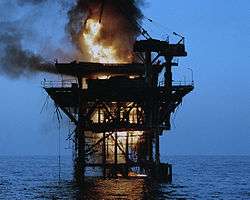Operation Nimble Archer
| Operation Nimble Archer | |||||||||
|---|---|---|---|---|---|---|---|---|---|
| Part of Iran–Iraq War, Operation Earnest Will | |||||||||
 An Iranian oil platform set ablaze after shelling by American destroyers. | |||||||||
| |||||||||
| Belligerents | |||||||||
|
|
| ||||||||
| Strength | |||||||||
|
6 warships 3 aircraft | 2 oil platforms | ||||||||
| Casualties and losses | |||||||||
|
None in the operation 18 injured in the attack on MV Sea Isle City, which led to the operation | 2 oil platforms destroyed | ||||||||
Operation Nimble Archer was the 19 October 1987, attack on two Iranian oil platforms in the Persian Gulf by United States Navy forces. The attack was a response to Iran's missile attack three days earlier on MV Sea Isle City, a reflagged Kuwaiti oil tanker at anchor off Kuwait. The action occurred during Operation Earnest Will, the effort to protect Kuwaiti shipping amid the Iran–Iraq War.
Iran subsequently filed an unsuccessful lawsuit against the United States for reparations at the International Court of Justice.
Operation
On 16 October, Sea Isle City was in Kuwaiti waters, waiting to be loaded. It had been escorted there by U.S. warships, but was not under their protection at the time.[2] An Iranian Silkworm missile launched from the Iranian-occupied Al-Faw Peninsula hit the ship's wheel house and crew quarters, blinding its master, a U.S. citizen[3] and wounding 18 crew members. The damage to the ship would take four months to repair.[4]
In retaliation, U.S. officials decided to attack two platforms in the Rashadat oil field (named Rostam oil field before 1979). Having been damaged by Iraq a year earlier, the platforms were not producing oil, but had been used by the Iranian Revolutionary Guard Corps for military purposes.[5]
Twenty minutes before the surface action group opened fire, USS Thach radioed the platforms, telling the crews to abandon them. At 2 pm, four U.S. destroyers opened fire: USS Hoel, USS Leftwich, USS Kidd, and USS John Young.[1] One platform was boarded by U.S. special forces, who recovered teletype messages and other documents, then planted explosives to destroy the platform. Air cover was provided by the cruisers USS Long Beach and USS William H. Standley, two F-14 Tomcat fighters and an E-2 Hawkeye from USS Ranger. The high-explosive shells did negligible blast damage to the steel-lattice platforms, but eventually set them ablaze.[1]

U.S. officials said the platforms were being used by Iranian forces as command-and-control posts with radars to track shipping in the area and communications gear to relay messages between the mainland and Iranian forces operating near the platforms. U.S. Defense Secretary Caspar W. Weinberger said Iran used the facility to "launch small boat attacks against nonbelligerent shipping."[6][7][8][9]
International Court of Justice case
On 2 November 1992 Iran filed suit with the International Court of Justice, the legal salvo that began a decade of claims and counter-claims by the United States and Iran. On 6 November 2003 the International Court of Justice ruled in favor of neither party, saying that "the actions of the United States of America against Iranian oil platforms on 19 October 1987 (Operation Nimble Archer) and 18 April 1988 (Operation Praying Mantis) cannot be justified as measures necessary to protect the essential security interests of the United States of America." The Court also ruled that it "cannot however uphold the submission of the Islamic Republic of Iran that those actions constitute a breach of the obligations of the United States of America under Article X, paragraph 1, of the Treaty of Amity, Economic Relations, and Consular Rights Between the United States of America and Iran,[10] regarding freedom of commerce between the territories of the parties, and that, accordingly, the claim of the Islamic Republic of Iran for reparation also cannot be upheld;"[11]
See also
References
- 1 2 3 Peniston, Bradley (2006). "Photos: Operation Nimble Archer". No Higher Honor. Retrieved 4 February 2013.
- ↑ "Ship flying U.S. flag hit; 18 wounded". St. Petersburg Times. St. Petersburg, Florida. 17 October 1987. p. 1.A.
- ↑ Tyler, Patrick E. (19 October 1987). "Blinded U.S. Captain Recovers After Attack; Glass Sprayed Head When Missile Struck". The Washington Post. Washington, D.C. p. a.16.
- ↑ "Counter-Memorial and Counter-claim submitted by the United States of America" (pdf). International Court of Justice. 23 June 1997. Retrieved 18 January 2015.
- ↑ Crist, David B. (June 2009). "Gulf of Conflict" (pdf). Washington Institute for Near East policy. Retrieved 18 January 2015.
- ↑ Moore, Molly (20 October 1987). "U.S. Destroyers Shell Iranian Military Platform in Gulf; Retaliation for Silkworm Attack Called "Measured and Appropriate"". The Washington Post. Washington, D.C. p. a.01.
- ↑ Serrill, Michael S. (2 November 1987). "The Gulf Punch, Counterpunch". TIME. Retrieved 18 January 2015.
- ↑ Roberts, Steven V. (20 October 1987). "U.S. Ships Shell Iran Installation In Gulf Reprisal". The New York Times. Retrieved 18 January 2015.
- ↑ Kelley, Stephen Andrew (June 2007). "Better Lucky than Good: Operation Earnest Will as Gunboat Diplomacy" (PDF). Naval Postgraduate School. Archived from the original (pdf) on 27 June 2008.
- ↑ http://www.parstimes.com/law/iran_us_treaty.html
- ↑ "Oil Platforms (Islamic Republic of Iran v. United States of America)". International Court of Justice. Archived from the original on 2 October 2006. Retrieved 12 December 2006.
Further reading
- Wise, Harold Lee (2007). Inside the Danger Zone: The U.S. Military in the Persian Gulf 1987–88. Annapolis: Naval Institute Press. ISBN 1-59114-970-3.
External links
- Nimble Archer as part of Operation Prime Chance
- Newspaper clips about Nimble Archer
- Photos of Operation Nimble Archer